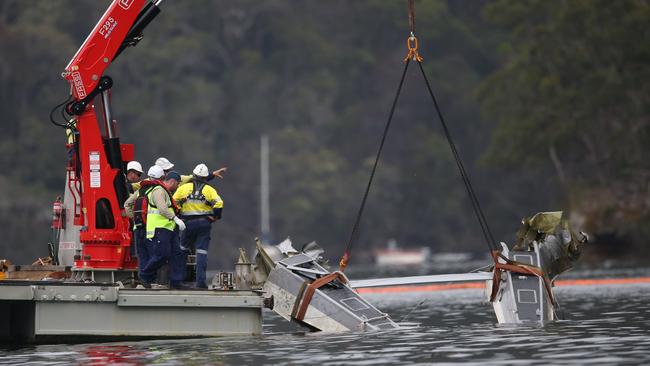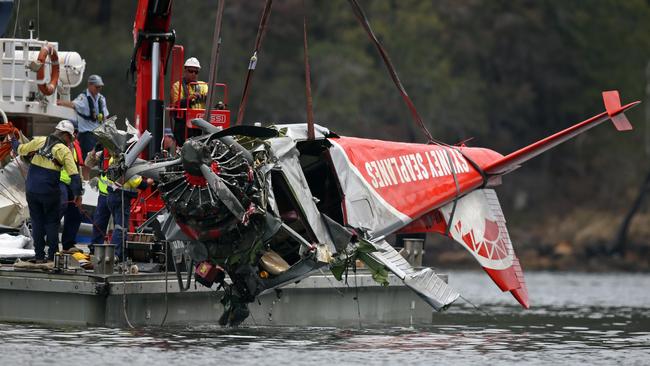Crashed seaplane wreckage recovered in three parts from Jerusalem Bay
Police divers have battled through limited visibility on the floor of Jerusalem Bay to recover wreckage of the seaplane which plunged into the water on New Year’s Eve.

Police divers have battled through limited to no visibility on the floor of Jerusalem Bay in Sydney’s north to recover three major parts of the seaplane which plunged into the water on New Year’s Eve, killing six people including multi-millionaire British CEO Richard Cousins.
Investigators have spent the last three days scoping out the crash site and formulating a plan to raise the plane from its resting place under 13 metres of water.
Detective Superintendent Mark Hutchings from the Marine Area Command, said the fuselage, or body of the plane, looked to have suffered extensive damage on impact when it was raised from the water this morning.
“From the time the wreckage was brought on the barge we saw there was severe damage to the plane and it appeared there had been quite an impact on hitting the water,” Det Sup Hutchings said.
Australian Transport Safety Bureau’s executive director of transport safety Nat Nagy said there were a number of elements that had been semi-removed from the fuselage either on impact or over the last few days and that to ease the recovery mission and ensure everything fit on the barge, the floats had been detached by police from the main body of the plane.
He said a wing, the floats or pontoons and the main body of the aircraft had been lifted from the water and onto the barge, with police divers still looking for other parts of the plane before it will be transferred to shore at Rowland Reserve in Baysview later this afternoon.
Mr Nagy said the team had not yet recovered any personal items or phones that they were aware of, and that his team would conclude their on-site investigation in coming days before returning to Canberra to analyse the collected eveidence.
The ATSB is expecting to publish a preliminary factual report within 30 days, with a more extensive record of findings to be handed down in 12 months.
“Over the course of the next 12 months we will complete a report that will aim to find out exactly what went wrong, with the goal of improving safety and preventing an accident like this happening again in future,” Mr Nagy said.
NSW Police confirmed they had been in contact with relatives of the victims - Richard Cousins, 58; his two sons William, 25, and Edward Cousins, 23; his fiancee Emma Bowden, 48, who worked as Art Editor of OK Magazine; her daughter Heather, 11; and pilot Gareth Morgan, 44 - and said some were headed to Australia to assist with the investigation.
The plane, a 1964 model de Havilliand Beaver owned by Sydney Seaplanes, took off from Cottage Point Inn just after 3pm on Sunday and turned to the north-west before making a sharp turn to the right and nosediving into the water.
Witnesses, including 32-year-old Todd Stellars, saw the plane flip on impact and rushed to help but could not rescue anyone from the quickly sinking aircraft.
The six bodies were recovered from the wreckage on the day and a coroner is yet to determine the exact cause of death.
Family says thank you
As the seaplane that crashed on New Year’s Eve in Sydney’s north is lifted onto a barge to be taken ashore so that authorities can begin their investigations into the accident, the family of one of the victims has expressed their thanks for support.
A statement has been issued from Simon and Andrew Cousins, who are the brothers of millionaire British CEO Rchard Cousins who was killed in the crash. The pair have travelled to Australia as the investigation continues.
“We are fortunate and thankful for the outpouring of love and support we’ve received from across the world. We are deeply touched by the tributes to Richard, William, Edward, Emma and Heather in the media and throughout the community.
We have now arrived in Australia and as the investigation continues, we would like to take this opportunity to thank all those involved for their dedication and commitment, in particular the Sydney Water Police and those members of the public who helped on the day of the accident. We are also thankful for the tremendous support received from Compass Group, Richard’s employer, the British Consulate General in Sydney and all those in Australia who have expressed their condolences.
On behalf of our extended families we thank you for allowing us to grieve privately during this difficult time and respect our decision to not participate in any media interviews.”

Seaplane a ‘rebuilt cropduster’
The seaplane that crashed north of Sydney killing six people on New Year’s Eve had a previous life as a crop duster and was reportedly “destroyed” in a fatal accident twenty years ago, an investigation report shows.
The Sydney Seaplanes 1964 model de Havilland Canada Beaver plunged into the Hawlesbury River after a sharp right turn on Sunday afternoon, killing millionaire British CEO Richard Cousins, 58; his two sons William, 25, and Edward Cousins, 23; his fiancee Emma Bowden, 48, who worked as Art Editor of OK Magazine; her daughter Heather, 11; and pilot Gareth Morgan, 44.
The aircraft, which is currently being floated to the river surface by police, had flown thousands of trips around Sydney since the early 2000s.
But an Australian Safety Investigation report from the late 90s shows the plane flew under a different registration in a previous life as a crop duster with the same serial number.
The plane allegedly set off from Armidale in the state’s north on November 15, 1996, and was preparing to spread a load of phosphate fertiliser on a nearby property when it fell into difficulty in gusty winds, Fairfax Media reports.
It then clipped a hillside with a wing and cartwheeled, a government report found.
The pilot was killed, and under “damage to aircraft” the investigators wrote the plane had been “destroyed”. They found that wind conditions, air density and the plane’s weight were all significant factors in the crash.
It is understood the aircraft was assessed by a specialist engineer who deemed the aircraft repairable.
It was then entirely rebuilt, recertified and owned by several more businesses before it was acquired by Sydney Seaplanes.
Parts of the plane are beginning to emerge from the water at the crash site in Jerusalem Bay.
The wreckage is expected to be completely recovered and delivered to Rowland Reserve in Bayview by the early hours of this afternoon.
Describing the Armidale crash, the Australian Transport Safety Bureau report said: “The aircraft did not seem to be climbing sufficiently to pass over the hill in front of it. The aircraft was then seen to be in a climbing left turn ... with superphosphate dumping from it. The aircraft’s left wingtip contacted the ground after which the aircraft cartwheeled and came to rest 200-300 meters from the superphosphate dump. The driver ran down to the aircraft and found the pilot still strapped in the seat with no apparent sign of life.”
Seaplanes Pilots Association vice-president Kevin Bowe said crashed planes were completely overhauled before re-use so they were as good as or better than new.
Aviation expert Neil Hansford said the fuselage was probably the only original part left on the aircraft.
“The engine on this particular aircraft has to come off every 1200 hours and this operator was pulling it off at 1100 and it’s basically return to new,” he told ABC Radio.
Authorities are using a floating crane to recover the plane, which is resting on its roof in about 15 metres of water, according to All Waterfront Constructions operations director Chris Kemp.
Mr Kemp, who will work to recover the aircraft, said two slings would be lowered and passed through the aircraft’s cabin by police divers.
“Then we’ll be lifting the whole lot up and placing it on the barge,” he told AAP.
“One of the wings is pretty badly damaged and bent over on the plane itself, so we’ll be pulling that back down and lashing it to the plane,” Mr Kemp said. The ATSB is working to determine why the seaplane went down. One possibility is the plane stalled.
Aircraft maintenance engineer Michael Greenhill told AAP on Wednesday that while it was not mandatory in Australia for Beaver planes to have stall warnings installed, most did.
“A stall is when the airflow over the aircraft’s wing becomes insufficient enough to produce lift,” Mr Greenhill said.
A Canadian report, published in September 2017, recommended the warning system be mandatory on all Beavers.
“Even if the Beaver had this system fitted there’s a large possibility there would have been insufficient time to rectify the situation due to the low altitude and approaching terrain,” Mr Greenhill said.
With AAP



To join the conversation, please log in. Don't have an account? Register
Join the conversation, you are commenting as Logout